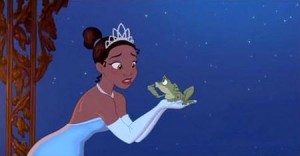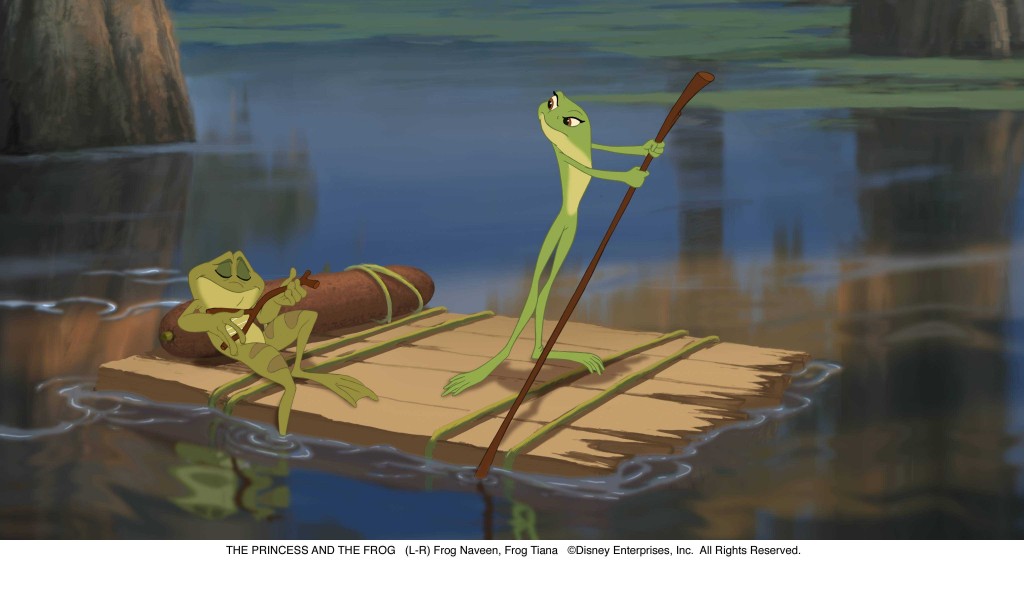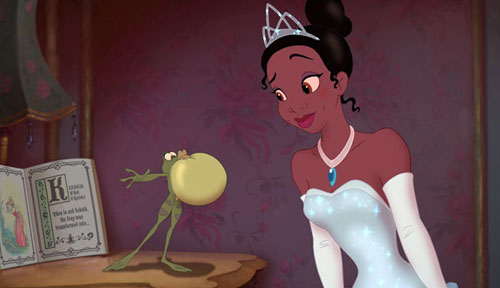 2D animation isn’t dead yet, dagnabit! It’s not surprising The Princess and the Frog won at the box office this past weekend (although the Mouse House might be a little disappointed with its $24.2 million take). The film is a wonderful reminder of how Disney truly is the king of hand-drawn animation, with the rich, lush backgrounds and a fluidity in the characters that you really can’t get anywhere else – and something CGI can’t quite accomplish, especially with the too-artificial performance-capture stuff director Robert Zemeckis loves so much.
2D animation isn’t dead yet, dagnabit! It’s not surprising The Princess and the Frog won at the box office this past weekend (although the Mouse House might be a little disappointed with its $24.2 million take). The film is a wonderful reminder of how Disney truly is the king of hand-drawn animation, with the rich, lush backgrounds and a fluidity in the characters that you really can’t get anywhere else – and something CGI can’t quite accomplish, especially with the too-artificial performance-capture stuff director Robert Zemeckis loves so much.
Executive producer John Lassiter made it a point, when Pixar and Disney merged, to make more Disney hand-drawn magic and so, brought back Little Mermaid and Aladdin writer/directors Ron Clements and John Musker to helm The Princess and the Frog. They skew the original fairy tale, setting it in 1920s New Orleans, where we meet Tiana (Ankia Noni Rose), a hard-working gal who is saving up to start her own restaurant, a dream her late father (Terence Howard) once had. But she gets sidetracked when she encounters a talking frog at a costume party. She’s dressed as a princess, you see, and he wants one little kiss. Of course, this frog is actually Naveen (Bruno Campos), a real prince visiting New Orleans who gets snookered by a witch doctor named Dr. Facilier (Keith David) and transformed into said amphibian. Thing is, once Tiana kisses Naveen, she turns into a frog herself because she isn’t a real princess. Then it’s a mad dash into the bayou to find Mama Odie (Jenifer Lewis), a Cajun voodoo lady, who can turn them back into humans. PATF plays very much like a romantic comedy — Tiana and Naveen don’t like each other much at first, but soon sparks begin to simmer into something more.
PATF also brings back the splashy musical numbers, with original music from Randy Newman, who, of course, is Lassiter’s go-to guy from the Toy Story days. Maybe not up to the same caliber as an Alan Menken/Howard Ashman score –the songs sort of all sounded the same to me – but still toe-tapping. My 10-year-old daughter’s barometer, however, might prove me wrong. She’s been singing the songs from the soundtrack for weeks now (we got an advanced copy of the CD; critics get perks, you know). Her particular favorite is “Dig a Little Deeper,” sung by Mama Odie. If I had to pick one, I liked Tiana’s “I want” song, “Almost There.”
And wouldn’t you know it? Disney has finally animated its first African-American princess. Anika Noni Rose is quite winningly as the voice of Tiana. I was able to join her, John Lassiter, Terence Howard and others in a panel discussion about the importance of The Princess and the Frog. Here are some of their comments and observations:
 John Lassiter: “When I was up at Pixar and when the studios down here decided that were not going to do hand drawn animation anymore, it broke my heart. Never in the history of cinema has a film been entertaining to an audience BECAUSE of the technology. It’s what you do with the technology. So when the merger of Disney and Pixar happen, the very first decision we made was we were going to bring back hand drawn animation. And as we started working on [The Princess and the Frog] and bringing people back, it was so exciting. Some of the artists left the studio that were working on hand drawn animation because they didn’t want to be kind of re-trained for computer animation. But some of the artists were re-trained. So we brought both of those groups back together and never have I worked a group of artists who had more to prove to the world; it was a dream team of artists. This art form is spectacular. And I asked from them to aim high. ‘Let’s make great art’ I said, so we chose two films to look at: Lady and the Tramp and Bambi. Bambi for the bayou, the nature and almost impressionistic qualities, and Lady and the Tramp for the humans, architecture and character design. Pinnacle of Walt Disney’s style.”
John Lassiter: “When I was up at Pixar and when the studios down here decided that were not going to do hand drawn animation anymore, it broke my heart. Never in the history of cinema has a film been entertaining to an audience BECAUSE of the technology. It’s what you do with the technology. So when the merger of Disney and Pixar happen, the very first decision we made was we were going to bring back hand drawn animation. And as we started working on [The Princess and the Frog] and bringing people back, it was so exciting. Some of the artists left the studio that were working on hand drawn animation because they didn’t want to be kind of re-trained for computer animation. But some of the artists were re-trained. So we brought both of those groups back together and never have I worked a group of artists who had more to prove to the world; it was a dream team of artists. This art form is spectacular. And I asked from them to aim high. ‘Let’s make great art’ I said, so we chose two films to look at: Lady and the Tramp and Bambi. Bambi for the bayou, the nature and almost impressionistic qualities, and Lady and the Tramp for the humans, architecture and character design. Pinnacle of Walt Disney’s style.”
Anika Noni Rose: “I think it will mean different things to different people in that theater. It will depend on what time they grew up in. For my nephew, it will be the norm. He will think nothing of it. It will be his first princess. Period. For my mother, it’ll be something she’s been waiting for – and her child, no less. For my grandmother, it will be something she never thought would happen. Each person who sits in that theater will have a different journey that will bring to the story and it will make the story different for them. So that is something really beautiful about what it is being made because … Disney is Americana, and we have simply opened a new chapter in Americana. Something that’s been here a very long time but hasn’t necessarily been shared. So in that respect, it’s just another step in the completion of the story of what America is in this fantasy world.”
Terence Howard: “And for me, I’m in complete agreement on what Anika is saying. When they were in talks, production on this film, Barack Obama wasn’t in the White House. So it is very apropos that we have two African-American princesses at the same time that this movie is coming out. It’s just a happy accident, a wonderful coinky dink. But there’s always been nobility in every culture and in every race, just the same way there have been geniuses in every culture and race. It’s nice to have Disney platform that.”
Anika Noni Rose: “I do remember wondering to myself if there would ever be a chocolate brown. After seeing Snow White, I mean, they NAMED it. [Laughs] Snow White, what! But I didn’t necessarily feel deprived as a child, you don’t know, you’re living in your world. I do remember strongly seeing Charlayne Woodard in a production on TV called Cindy – and it was Cinderella! And Charlayne Woodard was fantastic! I was shocked because it just wasn’t something that I thought was the norm. As far as being a role model, that’s difficult. I think it’s wonderful and I’m honored that people would think of me as a role model. On the other hand, I think that it is sort  of dangerous to choose a person and lift them up so high. I’m gonna play a role that somebody doesn’t like. At some point, they are going to be, ‘She was AWFUL!’ and think bad things. But I think if we can separate those things and think to yourself, ‘Wow, I really like how she’s handled her career. I like the way she handles herself as a person’ then I’m really honored and amazing. I hope it does push other children to look up and say, ‘See that star up, the one you can barely see that twinkles small, that’s one I’m going to grab.’ And they do it.”
of dangerous to choose a person and lift them up so high. I’m gonna play a role that somebody doesn’t like. At some point, they are going to be, ‘She was AWFUL!’ and think bad things. But I think if we can separate those things and think to yourself, ‘Wow, I really like how she’s handled her career. I like the way she handles herself as a person’ then I’m really honored and amazing. I hope it does push other children to look up and say, ‘See that star up, the one you can barely see that twinkles small, that’s one I’m going to grab.’ And they do it.”
Terence Howard: “I hope this movie will set a landmark and a precedent for other culturally diverse films. I’m very happy that Disney took this step, but I’m looking forward to having more of it. I mean, Disney has already covered most of the world in the films that they’ve made. The Little Mermaid was a fish, but every little girl could relate to that little mermaid. With Minnie Mouse and Mickey Mouse, you never wondered about whether they were black or white. Every child could relate and associate with it. I’m just looking forward to the numbers on this film coming back very well and being happy to have participated.”
John Lassiter: “What’s very important to me in making these films is that we wanted to make a DISNEY animated film. Something that feels like a very classic Disney animated film yet is brand new. To me, these films are like an engine that pulls a big train. There’s no other company like the Walt Disney company to take these characters and make them come alive and stay alive beyond the boundary of the film.”


One thought on “How Disney Finds Magic with a Princess and a Frog”
Comments are closed.